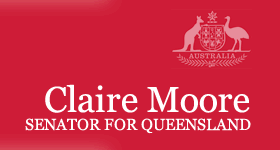Senator MOORE (Queensland) (6.52 pm)—
Last month on the Sunshine Coast over a thousand people gathered at the University of the Sunshine Coast Sports Stadium to mourn the passing of and to celebrate and talk about the life of an amazing woman, Dr June Canavan. Dr Canavan and her friend Keith Gracie, a local builder from the region who shared her strong community involvement, were killed in a plane crash on their way to fulfil a dream, a dream they shared with all the people who wanted to walk the Kokoda Trail. The sports centre was festooned with yellow flowers and many of the people who were there were dressed in Dr June’s favourite sunny colour. So many people were there to share their own experiences of Dr June: Olympic and national sports people, families and schoolchildren. They were all people who had had some contact with a woman who had truly changed their lives. As part of the process, her family, who had been overwhelmed by the support that they had received and by the outpouring of love and of grief, had put up a website on which they encouraged people to put forward their own experiences of Dr June. The website is truly an amazing place, Mr Acting Deputy President Humphries. If you get the chance, and I encourage anyone to do this, go to this website and learn about Dr June Canavan and the difference that she made.
Several words kept coming up consistently on the website about this woman, who turned to medicine late in her life, was a native of Wangaratta, having been born there and having gone to school there after which she did not go immediately into studying medicine. She went out and did other things and then turned to medicine in her 20s. As one of the website contributors said, she might not have been the absolute brightest student but she had enough heart for the whole class and turned into a truly remarkable doctor. People talked about the way that so many turned to Dr June for medical help and then turned into friends. Consistently it was stated how Dr June ‘was first my doctor and then my friend’ and how Dr June made such ‘a difference in my life’. They talked about the process by which she actually changed lives. They spoke consistently of her smile: ‘By all the things in life that you did you made me smile’ and ‘You created miracles every day.’ The process confirmed the fact that Dr June truly believed in working with and caring for her patients. There were many comments about the way in which she listened to the needs of the patient. She listened to her patients and then, as we saw consistently, she left ‘no stone unturned in the way she sought to find ways to help people to make the choices that they had to make’. She ‘always made it easy to understand what was occurring with my injuries and she showed so much compassion’. She was a ‘truly caring doctor’:
She took the time to actually listen to what her patients were saying and to keep searching for an answer when other doctors would have given up long ago.
Many people, particularly her professional peers, talked about her stubborn tenacity and her relentless pursuit to make sure that people reached their goals. She was a ‘wonderful caring doctor and true friend’ who ‘gave real hope and help when we were out of options’.
Dr June was killed when she was in the middle of a process that she had put in place in June 2008, launching a project called ‘Klocking up the Ks’. Her aim was to climb five mountains whose names all began with the letter K during 2009 and to achieve sponsorship for each step that she took for the cause of the St Jude orphanage, which had been set up in Tanzania. Mr Acting Deputy President, you may well know the story of St Jude’s. It was set up by an Australian woman as an orphanage and, as the School of St Jude, is looking at education for people with genuine disadvantage in Tanzania. Gemma Sisia, the woman who set it up, has recently toured Australia seeking further sponsorship and she met with Dr June at that time, leading to the five-Ks plan. The process that Dr June had put in place had been almost completed. She had climbed Kiel Mountain, outside the Sunshine Coast, Mount Kosciuszko and Mount Kinabalu, and had been on her way to Kokoda. This process was going to end with climbing Mount Kilimanjaro and at that stage Dr June was hoping that she would have about $50,000 to put towards her chosen charity.
The community around the Sunshine Coast were caught up in her program to raise this money because she was such a strong community person who drew people into her circle and encouraged them to take up hope. One of the contributions left on her website was put there by the students of grade 6TS at St Thomas’s School Mareeba, in Far North Queensland. I quote it now because I think the kids have actually poured out their own feelings about what happened to their new friend, Dr June:
Dr June visited our class last term and we feel very privileged to have met her. She was very inspirational as she explained her goals and told us about the school of St Jude. We thought she was very kind-hearted, adventurous and generous. Because of Dr June, our school is participating in ‘Klocking up the Ks’ by running laps of our school oval each week for 6 weeks, and collecting money as sponsorship and donations. We are trying to run as many kilometres as Dr June was planning to climb. We have painted a mountain and are keeping track of our progress. We are now even more committed to raising money for the School of St Jude so we can honour the memory of Dr June. We are even thinking of having an annual fundraising event so we can always remember Dr June. We feel very lucky that we had the chance to meet such a wonderful person who had such an enthusiasm for life and for helping others.
Another contribution to the website was from the Mountain Creek State School Student Council, students and staff. It talked about the way Dr June was concerned with sport and how she was known so far and wide for her interest in sports medicine. It said:
Sport was important to you. You inspired athletes who, like you, wouldn’t settle for the ordinary or the mundane, but aimed for the stars. You would diagnose, treat and ensure a successful recovery to allow athletes to return to high performance of body and mind. You always gave your time so willingly.
And that was a consistent message. Someone said that she was probably the busiest person she ever knew, but, in giving up time to be there to help someone throughout their illness or some bad times, Dr June was always there for them.
John Mendoza, ex-CEO of the Mental Health Council, was a good friend of Dr June Canavan and put a tribute on the website. They were friends, they had worked together in the sporting area, but what John talked about in his tribute was something that I feel very strongly about—that is, the issue of mental health. I quote from John’s tribute:
In 2005, at the time of the release of “Not for Service” Report June rang me and said she would do whatever she could to support the messages from the report about the woeful state of mental health services in Australia. She had numerous first hand experiences of helping patients and their families and managing serious episodes of mental illness with little or no access to acute care services. She was there 24/7 for those who needed her.
It went on to say that June put her enthusiasm into practice and that with her knowledge of sports medicine she was a true expert who understood the serious risks and consequences that come from participation in elite sport from a mental health perspective. He goes on to say that she was always looking at learning and self-development, and in 2007 at the age of 57 she enrolled at the University of Lausanne to do a doctorate on the issues around the impact of elite sport and mental health.
It is so important that we as a community know the difference that Dr June Canavan made to so many people. Her family at this wonderful service on the Sunshine Coast talked about her importance to them, the way she was always there for her family, and the inspiration she was for people to move onwards and do better and achieve their goals. There was a great deal of sadness among the community with the passing of Dr June Canavan; she made a genuine difference to so many lives. She set goals for herself and for other people and she helped people to achieve those goals. The world was a much better place for the work that June Canavan did in her life—naturally for the area of sports medicine, and most particularly for so many patients who relied on her—and I give my messages of sympathy and also celebration to her family. I thank June Canavan for her life.




